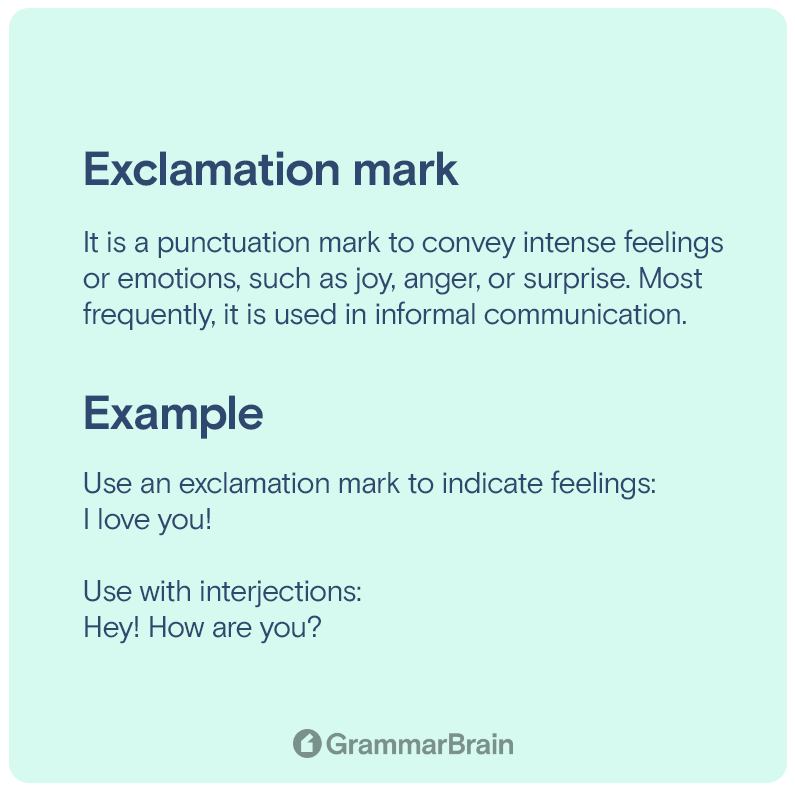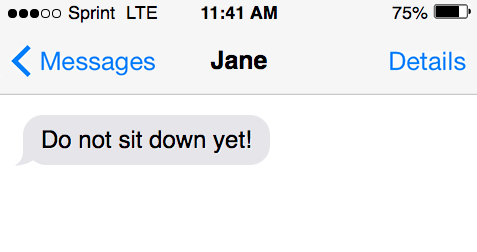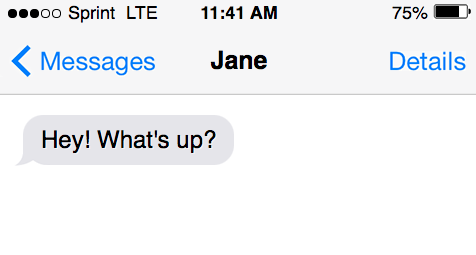The symbol for the exclamation mark is a period with a vertical line on top of it: (!) It is known to be used in informal communication as a shriek or a bang, and it is always used in a short phrase or at the end of a sentence, which usually expresses a very intense feeling. But how should it get used properly?
Learn about the exclamation mark in this short worksheet…
Exclamation Mark or Point
In North America, the term exclamation point is more widely used against calling it an exclamation mark. However, globally, it is referred to as an exclamation mark, not a point. More so in countries that use British English. Depending on the audience, you can use either of the terms, but don’t forget to be consistent with whichever term you use.

What is the Exclamation Mark?
It is a punctuation mark to convey intense feelings or emotions, such as joy, anger, or surprise. Most frequently, it is used in informal communication.
Use of it should be limited to informal writing and can get used in formal communication only if it is essential.
For example, it is customary to use exclamation marks to express ordinary speech, such as in novel writing. However, they are mostly out of place when used in formal writing.
Also, using them often will make your work seem breathless and almost childlike.
| Rule | Example |
| Use an exclamation mark to indicate feelings | I love you! |
| Use with interjections | Hey! How are you? |
| Use with a non-question sentence beginning with what | What dummies we are! |
| Use in informal communication | He is so pretty! |
When Is the Exclamation Mark Used?
An exclamation mark is used when you want to express intense emotion in your written communication. The intensity of the mark can often get misinterpretted.
It can also risk making your sentence seem a bit rude at times.
The critical aspect of using an exclamation mark is to understand how it changes the very tone of your statement or sentence and whether it is truly doing what you want it to do.
Exclamations change a declarative sentence into an exclamatory sentence. When writing a declarative sentence, you are essentially making a simple or straightforward statement.
Changing the period at the end of your sentence with an exclamation mark makes an exclamatory sentence, which displays intense or strong emotions.
For example, you are making a simple statement such as I love dogs. The same can be changed into an exclamatory sentence by putting an exclamation mark at the end of the sentence I love dogs!
Thus, this expresses your emotional love for dogs in written communication more abruptly.
Similarly, if you make a statement such as “Why did you disobey me, Jack?” Now, if you put an exclamation mark at the end of the sentence in place of a question mark, it will express your anger, like “Why did you disobey me, Jack?!” letting your audience know that you were angry with Jack.
Understanding the exclamation mark use
Strong Voice
Some examples of how to use an exclamation mark to express a strong emotion or feeling:
- Wow! you delivered a brilliant performance!
- Stop it!
- Do not sit down yet!
- Are you insane!
- I’m genuinely craving ice cream tonight!
- Stand up!
- Someone, please call 911!

Interjection
Quite a few interjections require exclamation mark, some examples:
- Hey! What’s up?
- Oi! Can you turn it down?
- Stop! I have to leave now.
- Holy cow! I am running late for my meeting.

Non-Question Sentences
Typically, a non-question statement begins with a what or how and often are exclamation and therefore requires an exclamation mark at the end of the sentence.
Some examples:
- What on earth is going on!
- How can you forget such a simple point!
- What the heck!
- How am I supposed to bring her back!
- What is wrong with you!
- What a stupid thing to do!
Informal Writing
Often when writing personal emails or letters, many people use two or three, or more exclamation marks.
Some examples:
- I really miss you baby!!
- Why have you not replied to my mail!!!
- Do did you forget to invite Martin!!!!
- I will be in time for the dinner!!
Using Exclamation Marks with Proper Names
It may sound strange and look strange, but an exclamation mark is often used with proper nouns, such as places and people, to stress a point.
Essentially, this emphasizes that the speaker or the writer is conveying an emotion that draws the audience to the name.
Some examples:
- Panic! at the disco (At one point, the band had an exclamation mark in its name, and it was dropped in the year 2008)
- P!nk (Her name is said to be a tribute to Mr. Pink – Steve Buscemi from the movie Reservoir Dogs)
- Ann! I need you to stop right now!
- Elliot S! Maggin, the comic book author (he once typed the exclamation mark in his name by mistake, and the editor loved it, and it became part of his name from then on)
Using Exclamation Marks with Place Names
You will not often come across a place name with an exclamation mark. However, there are a few such examples:
- Westward Ho! (The only place located in the British Isles which has an exclamation mark in the name, it is also the name of a book)
- Saint-Louis-du-ha! -ha! (The exclamation mark was added to give it local colloquialism)
- Hamilton! Ohio, the local citizens voted to put an exclamation mark to emphasize the name of their town.
What Is the Point of an Exclamation Point?
Remember, there is no difference between an exclamation point and an exclamation mark. Both are punctuation used at the end of the sentence in most cases.
The symbol for both is a period with a vertical line sitting on top: (!)
The exclamation point is another name for the exclamation mark. It is more popular in the United States of America, where it is called an exclamation mark in British English, and countries that use British English in their communications.
The exclamation point punctuation is to add emphasis and intensity to writing tones.
Change Declaration into Exclamations
A declarative sentence makes a simple, straightforward statement, if you want to express strong emotion in your declarative sentence, you should change it into an exclamatory sentence.
You must use What or How when you want to change a declarative sentence into an exclamatory sentence.
You must use what a/an before an adjective and a noun and use how before an adjective in the absence of a noun.
Examples
Declarative sentence:
- She is not obedient.
- Mumbai is a very large city.
- He is a good singer.
- She performed splendidly.
- We are very lucky.
- Steel is highly useful.
- Tanya is a pretty young girl.
- He has a lively smile.
The above examples changed into exclamatory sentences:
- How is she obedient!
- What a large city Mumbai is!
- How well he sings!
- What a splendid performance by her!
- How lucky are we!
- How very useful is steel!
- What a pretty young girl is Tanya!
- What a lively smile he has!
Emphasize Interactions
An exclamation mark is used at the end of a sentence or after a word or group of words to emphasize the point you want to make or express intense emotion. It is one of how a writer can express how he or she wants how their words might sound if spoken.
When writing informally, you can use multiple exclamation marks sometimes to express strong feelings or emotions. However, while writing formally, use only one exclamation mark and no more, or avoid using exclamation marks completely.
Examples
Declarative sentences:
- She is fortunate.
- They are a generous family.
- I was pleasantly surprised.
- Gold is a precious metal.
- You are a brilliant performer.
Emphases sentences:
- She is an extremely fortunate woman!
- Theirs is a highly generous family!
- It was indeed a very pleasant surprise!
- Gold is a highly precious metal!
- You perform superbly!
Turn requests into commands
You can use exclamation to convert your declarative statement into a commanding one.
It is used when you want to communicate in an authoritative style.
Examples
Examples of converting declarative statements into commanding statements.
Declarative sentences:
Commanding sentences:
- Open the door!
- Eat your lunch now!
- Better be my friend!
- Don’t be this stupid!
Common questions
The top common questions for exclamation marks are:
- Is it an exclamation point or an exclamation mark?
- Can exclamation be used as a figure of speech in a sentence?
- Which part of the speech can be an exclamation?
- How does one pen down an exclamatory statement?
- What does an exclamation mark indicate after hi?
- Does Happy Anniversary have an exclamation mark?
- Can an exclamation mark be used after greetings?
- When must exclamation marks not be used?
- Is it ok to use an exclamation mark or point after “thank you”?
- Does exclamation mark use imply shouting?
Is it an exclamation point or an exclamation mark?
Both terms are acceptable to use.
Can exclamation be used as a figure of speech in a sentence?
It can assist in helping to present the figure of speech in informal writing and narrative writing.
Which part of the speech can be an exclamation?
Interjections are the most common part of speech that can become an interjection.
Does Happy Anniversary have an exclamation mark?
Yes. Happy Anniversary! And other greetings can have exclamation marks to present emotion.
Does exclamation mark use imply shouting?
In many cases, yes. The reader interprets this as a loud voice.
Is it ok to use an exclamation mark or point after “thank you”?
Yes, in informal writing (for example, not an essay), you can say, “Thank you!”
What does “?!” mean?
The symbol ?! or !? are called interabang or interrobang and were proposed first by Martin K. Speckter in 1962. These symbols are non-standard punctuation marks used in written communication to merge the functions of the interrogative point or question mark along with the exclamation point or exclamation mark.
The question mark and exclamation symbol usually express surprise, excitement, or disbelief.
Example
- What have you been up to?!
- Why the hell did you not show up on time?!
- Who will clean up this mess behind you?!
What Does It Mean When (!) Gets Used in a Sentence?
A sentence that ends with an exclamation mark or symbol means that you are expressing your intense emotion to express anger, disbelief, shock, command, or surprise. It should be avoided in your formal communications.
Sources
- https://turtl.co/blog/weird-wonderful-and-wacky-punctuation/
- https://examples.yourdictionary.com/exclamatory-sentence-examples.html
- https://www.sussex.ac.uk/informatics/punctuation/stopsandmarks/exclamation
Inside this article
Fact checked:
Content is rigorously reviewed by a team of qualified and experienced fact checkers. Fact checkers review articles for factual accuracy, relevance, and timeliness. Learn more.
Core lessons
Glossary
- Abstract Noun
- Accusative Case
- Anecdote
- Antonym
- Active Sentence
- Adverb
- Adjective
- Allegory
- Alliteration
- Adjective Clause
- Adjective Phrase
- Ampersand
- Anastrophe
- Adverbial Clause
- Appositive Phrase
- Clause
- Compound Adjective
- Complex Sentence
- Compound Words
- Compound Predicate
- Common Noun
- Comparative Adjective
- Comparative and Superlative
- Compound Noun
- Compound Subject
- Compound Sentence
- Copular Verb
- Collective Noun
- Colloquialism
- Conciseness
- Consonance
- Conditional
- Concrete Noun
- Conjunction
- Conjugation
- Conditional Sentence
- Comma Splice
- Correlative Conjunction
- Coordinating Conjunction
- Coordinate Adjective
- Cumulative Adjective
- Dative Case
- Determiner
- Declarative Sentence
- Declarative Statement
- Direct Object Pronoun
- Direct Object
- Diction
- Diphthong
- Dangling Modifier
- Demonstrative Pronoun
- Demonstrative Adjective
- Direct Characterization
- Definite Article
- Doublespeak
- False Dilemma Fallacy
- Future Perfect Progressive
- Future Simple
- Future Perfect Continuous
- Future Perfect
- First Conditional
- Irregular Adjective
- Irregular Verb
- Imperative Sentence
- Indefinite Article
- Intransitive Verb
- Introductory Phrase
- Indefinite Pronoun
- Indirect Characterization
- Interrogative Sentence
- Intensive Pronoun
- Inanimate Object
- Indefinite Tense
- Infinitive Phrase
- Interjection
- Intensifier
- Infinitive
- Indicative Mood
- Participle
- Parallelism
- Prepositional Phrase
- Past Simple Tense
- Past Continuous Tense
- Past Perfect Tense
- Past Progressive Tense
- Present Simple Tense
- Present Perfect Tense
- Personal Pronoun
- Personification
- Persuasive Writing
- Parallel Structure
- Phrasal Verb
- Predicate Adjective
- Predicate Nominative
- Phonetic Language
- Plural Noun
- Punctuation
- Punctuation Marks
- Preposition
- Preposition of Place
- Parts of Speech
- Possessive Adjective
- Possessive Determiner
- Possessive Case
- Possessive Noun
- Proper Adjective
- Proper Noun
- Present Participle
- Prefix
- Predicate



